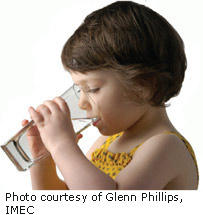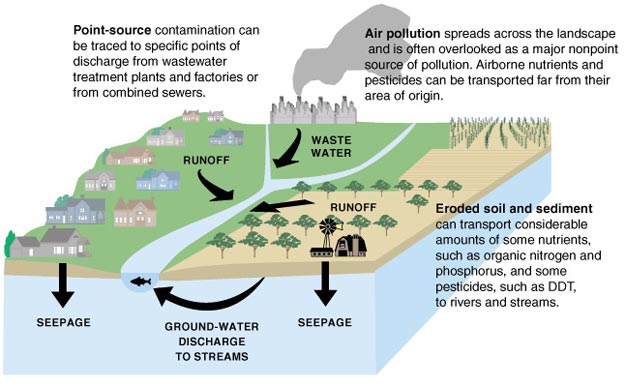Water quality is a term used to describe the chemical, physical, and biological characteristics of water, usually in respect to its suitability for a particular purpose. Although scientific measurements are used to define a water’s quality, it’s not a simple thing to say that “this water is good,” or “this water is bad.”
After all, water that is perfectly good to wash a car with may not be good enough to serve as drinking water at a dinner party for the President! When the average person asks about water quality, they probably want to know if the water is good enough to use at home, to play in, to serve in a restaurant, etc., or if the quality of our natural waters are suitable for aquatic plants and animals.
As the diagram below shows, assessment of the occurrence of chemicals that can harm water quality, such as nutrients and pesticides in water resources, requires recognition of complicated interconnections among surface water and ground water, atmospheric contributions, natural landscape features, human activities, and aquatic health. The vulnerability of surface water and ground water to degradation depends on a combination of natural landscape features, such as geology, topography, and soils; climate and atmospheric contributions; and human activities related to different land uses and land-management practices.
More and more nowadays we are hearing about situations where the quality of our water is not good enough for normal uses. Bacteria and microorganisms have gotten into drinking-water supplies, sometimes causing severe illness in a town; chemical pollutants have been detected in streams, endangering plant and animal life; sewage spills have occurred, forcing people to boil their drinking water; pesticides and other chemicals have seeped into the ground and have harmed the water in aquifers; and, runoff containing pollutants from roads and parking lots have affected the water quality of urban streams.
Yes, water quality has become a very big issue today, partly because of the tremendous growth of the Nation’s population and urban expansion and development. Rural areas can also contribute to water-quality problems. Medium- to large-scale agricultural operations can generate in animal feed, purchased fertilizer, and manure, more nitrogen and phosphorus than can be used by crops or animals. These excess nutrients have the potential to degrade water quality if incorporated into runoff from farms into streams and lakes All this growth puts great stress on the natural water resources, and, if we are not diligent, the quality of our waters will suffer.
Source: http://ga.water.usgs.gov/



